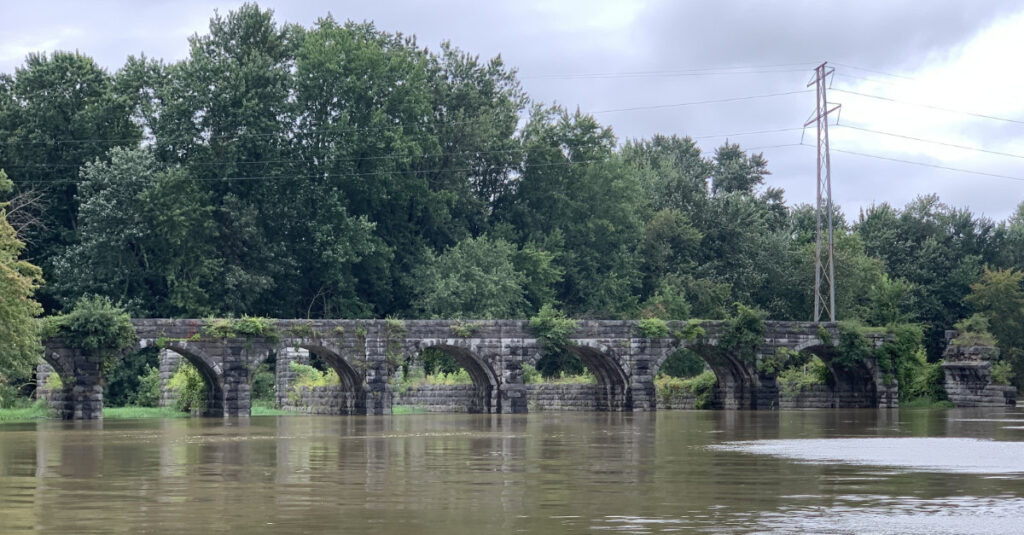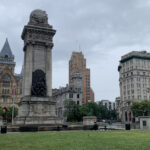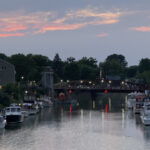August 19: Rain, flooding, closed locks, and a lucky break.
Thursday was a difficult day, right from the start.
Rain, Rain, and More Rain
It rained all night long. It was still raining in the morning when we woke up, in the dark, and prepared for an early departure.
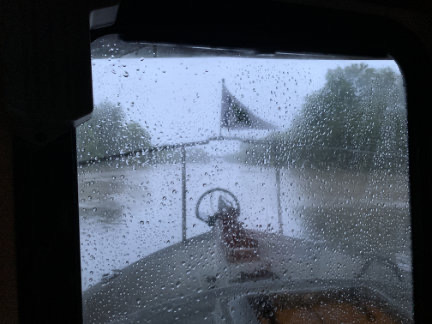
My view out the watch seat window as we left the harbor. Yes, there is a windshield wiper there, but the sound of the motor gets on my nerves so I prefer it to be shut off when I don’t need it.
Capt Paul took the helm as we motored out of Syracuse Inner Harbor not long after 6 AM. The area was even more debris-filled; Onondaga Creek, which fed into the harbor and eventually the lake, was at flood stage, spitting out silty water, branches, and logs. The current from the creek was strong at the end of the harbor, but it wasn’t bad enough to affect control of the boat. We entered the flow and went with it down toward Onondaga Lake.
The water level was higher. That meant we scraped the VHF antenna worse on the last bridge. (I’m not sure why we didn’t take it down; I suspect Capt Paul simply forgot.) No damage was done, but it was unnerving for me to watch through one of the skylights, hear the scraping sound, and not be able to do anything about it. Fortunately, the mast was still at least a foot or two below the bridge bottom.
There was even more debris at the mouth of the channel leading into the lake. Capt Paul took it slow and steered around it.
We headed out up the lake. Visibility was about a mile, Capt Paul put on the fog horn. I kept an eye out for more debris and other boats. Although we seemed to be the only boat out on the water — at 6:30 AM on a rainy Thursday; go figure! — there were floating platforms that looked a bit like boats. We went around each of them and kept going.
Visibility had improved by the time we got to the outlet that would lead us back to the canal. The rain had even let up a bit. We entered that channel, leaving the lake behind us, followed its west fork to the canal, and made a left.
We had two destinations for the day: Lyons, where we could get fuel that we’d really need by the time we got there, and Newark, for our overnight stay.
Flooding
It was no secret that the rain was causing flooding. We saw it everywhere as we motored along, mostly at no wake speed past homes, docks, and campgrounds. The farther we went, the more flooding we saw.
Flooding is something I don’t see very much. In the desert, when there’s enough rain to cause a flood, it’s usually a flash flood that rushes through and then dries up. But this was real flooding, the kind that comes up slowly and stays high, sometimes for days.
Understand that just as the beginning of our journey on the Erie Canal had us in the Mohawk River bed for much of the time, this part of the journey had us in the Seneca River bed. Unlike an isolated canal that’s fed only from locks and dams, rivers have other tributaries feeding water into them. All of this water was being dumped into the canal system. There wasn’t much the canal management could do to stop the flooding, so the water kept coming up.
We’d noticed high water the day before and figured it was about a foot higher than normal. But that morning, it was at least two feet higher, with fixed docks under water and water coming up on land.
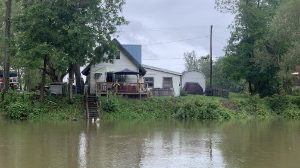
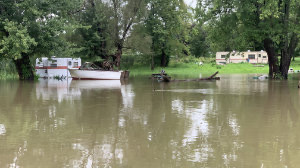
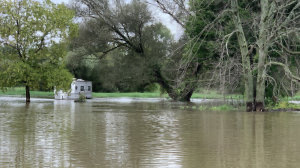

I took some photos of the flooding throughout the day. It was bad and getting worse.
In one of the canal reference books, I read that when there was flooding, they sometimes had to close the locks. I hoped this wouldn’t be an issue for us. We already had a long day ahead of us and I didn’t want any delays. But we had no trouble getting through Lock 24 in Baldwinsville, so I figured everything was okay.
Little did I know.
We motored along, increasing speed where there were no homes or docks and limiting speed to a friendly 5 knots when there were boats or structures that could be bothered by our wake. After a while, Capt Paul gave me the helm and Dianne took my place in the watch seat. I continued along the same way, speeding up a bit when I could and slowing down in no wake areas.
Of course, no matter how slow you go, it’s never slow enough for some people. We were near Cross Lake, at a turn toward the lake, when folks on land on the port side of the boat started yelling at us. I looked down at my speed; it was right around 5 knots. Apparently, that wasn’t slow enough for them. I was already past them when we realized that the flooding might make it necessary to go slower than five knots; I slowed down more near boats and docks from that point on to avoid future scolding. But at the pace we were making, it would be a very long day.
Little did I know.
The Canal Boats
The first replica canal boat we saw was the Seneca, which we overtook just before noon near one of the spots where the Canal leaves the Seneca River. This turned out to be just one of a fleet of nearly identical rental boats, each named for a geographic feature of New York State.
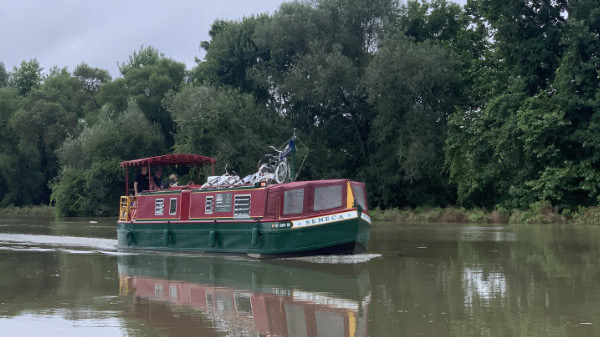
Passing the Seneca canal boat.
These boats rent by the 3-day or 7-day period. They’re low and long and can accommodate at least four people. We saw a lot of them in the next few days. Every single one had bicycles on the roof.
Despite passing the Seneca right before lunch, we’d see her again and again throughout the day. I’m pretty sure she was instrumental in us reaching our destination that evening, as you’ll learn below.
Aqueduct Remains
A little farther on, we passed the ruins of the one of the original Erie Canal’s aqueducts. I snapped some photos.
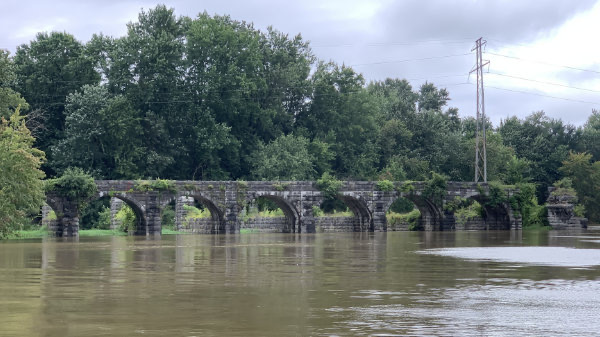
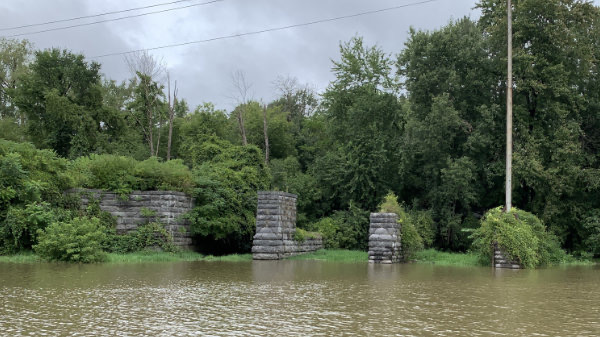
Remains of one of the original Erie Canal aqueducts could be seen along the canal.
The original Erie Canal, which was built in the early 1800s (not a typo) was a relatively narrow, shallow channel for moving barges full of goods. Back in those days, there were no motorized vessels so the barges were pulled by mules that walked alongside the canal on a tow path.
The original canal did not run in any river bed. In fact, when it reached a river, it had to cross over it. That’s what the aqueducts were all about. They were structures filled with water that carried the canals over rivers in their paths.
When the canal was rebuilt in the early 1900s, motorized vessels were available. These vessels were also considerably larger. The canal was rerouted to run in riverbeds like the Mohawk and Seneca, which were dredged to make channels and dammed to enable locks to bypass rapids and falls. The old aqueducts weren’t needed. In fact, they were in the way. So they were removed.
Still, along the path of the canal, in a few places, you can see traces of the old aqueducts. You can also find traces of the old canal along its original path which, in some cases, is quite a bit removed from its current path.
Lock 25
After nearly making a wrong turn that would have taken us down the intersecting Cayuga and Seneca Canal to two of the Finger Lakes, we motored up to Lock 25. I was on the bow, Capt Paul was back at the helm (after Dianne’s turn there), and Dianne was out back. Capt Paul called the lock to request locking up.
He waited for a response, but none came.
He called again. This time, the radio came to life. “Westbound vessel, the locks are closed indefinitely due to high water.”
This surprised me. I’d checked the Erie Canal website’s Alerts pages twice that day, most recently at around 10:30 AM when Dianne took over for me at the helm.
As if reading my mind, the lock keeper continued, “It was announced in a Notice to Mariners at 11 AM.” By this time, it was about 1 PM. I hadn’t checked in the past two and a half hours. My bad.
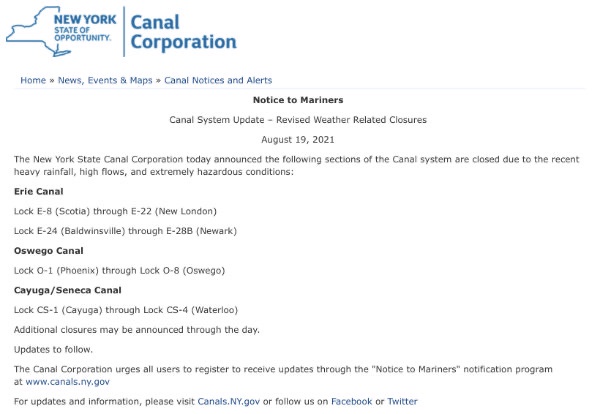
The notice to mariners that was released just two hours before we reached Lock 25.
We asked how long he thought the lock might be closed. “Last time this happened, it was about a week,” he said. “But I think it’s worse this time.”
So he was basically telling us that we were trapped between Lock 24 and 25 with limited fuel and no place to refill. We also had limited drinking water and food. And did I mention that I hadn’t noticed any marinas or docking areas in at least the previous two hours of traveling?
There certainly wasn’t anything at Lock 25.
My mind went into situation salvage mode. Tackle one problem at a time. The first problem was the boat, which was drifting. Like me, Paul seemed very eager to secure it.
When asked, the lock keeper got permission for us to tap into power for the night. He came down from the lock and opened the power box and moved a floating dock for us. He warned us that water levels could come up and if we were parked at the wall, the boat could be lifted onto the wall if the water rose enough. He seemed to think that it would.
Paul evaluated our options. He decided to tie the boat with its back end against that floating dock and the front end and side secured to some red metal posts sticking out of the water that were used to tie up work barges. To do so without damaging Nano, he had to rig up a fender board. He had all the parts for it and got to work. I helped.
Meanwhile, Dianne was focused on somehow getting fuel for Nano. She made a lot of phone calls and reported everything she learned, whether it was helpful or not. I tuned her out. Honestly, I feel that when life throws you a curve ball, you really do have to work out the problems one at a time. My problem — and apparently Paul’s — was getting Nano secured. Listening to her report that a gas station X miles away had diesel but no cans to put it in and they weren’t allowed to deliver anyway wasn’t helping me (or Paul) solve our current problem. I didn’t need to be distracted by information that wasn’t helpful. So I just did my best to ignore her.
At the same time all this was happening, Seneca — remember that canal boat? — had pulled up to the lock and gotten the bad news. It was being tied up on the wall on the opposite side of the canal.
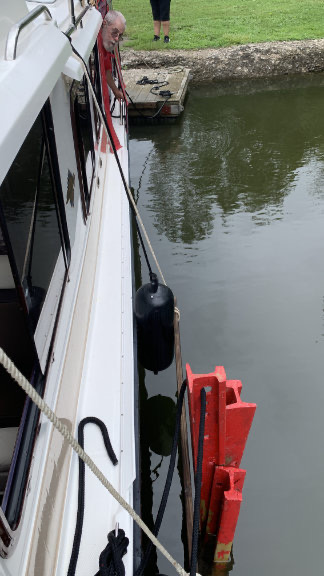
Here’s Nano (almost) tied up to the work barge posts. Note the fender board between the boat and the posts. You can see Paul’s head poking out of the boat.
Paul built the fender board and we strung it up to the side of the boat. Then he moved Nano back into position. Dianne tied the boat’s stern to the little floating dock. I worked with Paul to reposition the fender board and then run a rope through a hole at the top of one of the red metal posts.
That’s when the lock keeper called us on the radio. I hurried into the boat to answer it. Apparently, he’d gotten permission to let us and Seneca — which was a rented cruise boat, after all — through the lock. In fact, he’d managed to get us clearance all the way through to Newark. Beyond that, all of the locks were still open.
The only catch: We’d have to go all the way to Newark and we’d have to travel with Seneca.
We agreed.
A while later, we were untied from the floating dock and posts and slipping into the lock. Seneca slipped in behind us. They closed the lock doors and we started climbing. When the doors at the top opened, I was very glad to put Lock 25 behind us.
We started our slow slog up the canal toward Lock 26 with Seneca right behind us.
The Race to Newark
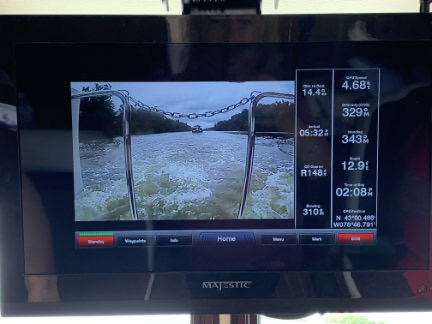
For a while, we monitored Seneca in our rear camera on the TV monitor in the main cabin.
By this time, it was about 2 PM. The locks were supposed to close at 5 PM. It was 6 miles to Lock 26, 12 miles to Lock 27, 1 mile to Lock 28A, and another 4 miles to Lock 28B. Seneca’s speed was restricted to 5-6 knots, so we were looking at another 4 hours of traveling — if we stuck with Seneca. Our cruising speed was the canal speed limit: 10 knots.
We also needed to get fuel, which was available at a marina just past Lock 27 at Lyons. They closed at 5 PM, too.
We pulled away from Seneca about two thirds of the way to the first lock. Capt Paul just didn’t want to drive that slowly. We got to the lock and called in, half expecting them to make us wait for Seneca. But instead, the lock keeper opened the lock and let us in. He knew we were supposed to wait for Seneca, but he closed the doors anyway. That’s when Seneca called; Dianne told the lock keeper we were supposed to stick together so he opened the door back up. Seneca slipped in. The door closed, the water rose, and the top door opened. We pulled out.
For the next lock, we made no pretense of waiting for Seneca. We had to get to the marina for fuel before they closed.
When we got to Lock 28, another boat was waiting. The lock keeper let us in together. We rose up and got let out the top. The other boat — a small tug style with just one person on board — passed us as we turned into the marina.
We really did need fuel. Our 100 gallon tank took nearly 80 gallons of fuel. That’s a tight reserve in a place where fuel is relatively scarce.
The marina only took cash. I had a bunch of cash with me — or thought I did. I couldn’t find it. I nearly tore my sleeping area apart looking for it. Then, not wanting the mom and pop owners to wait, I scraped together what I had and, with $40 from Dianne, came up with the $324.50 we needed. I had $3 cash left.
We left the marina and continued on our way, all sense of urgency now gone. We knew the lock keepers would wait for us — they had to wait for Seneca, which hadn’t passed us. We climbed up Locks 28A and 28B alone. As we emerged from Lock 28B, we saw Newark ahead of us.
It was nearly 7 PM when we docked. We’d been traveling for about 13 hours.
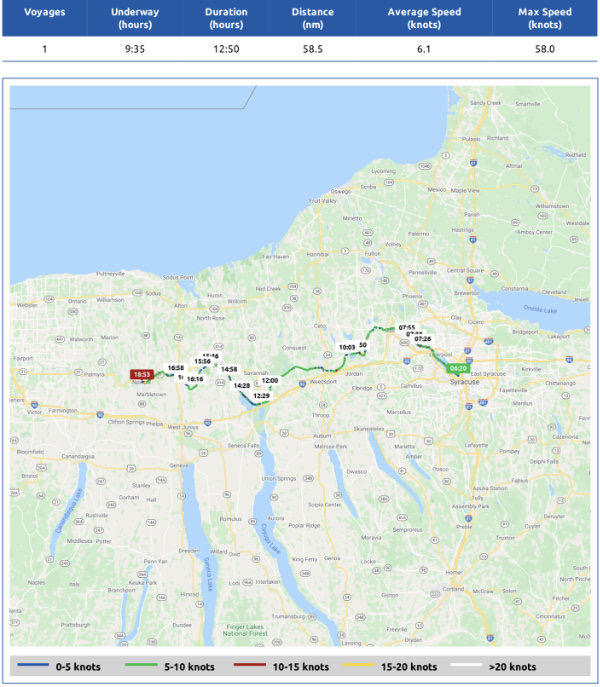
Day 10 on Nebo.
At Newark
I’m exhausted just writing about this, but I will finish up.
Newark turned out to be one of the best places we’d stopped so far. Why? Everything was free — including laundry and pump out! — and the people who managed the place were very friendly. Restaurants and groceries were within walking distance. The others stuck at the dock with us were also friendly, including the little tug guy and a handful of others who had been heading east and had been forced to turn around. Even Seneca finally chugged its way in.
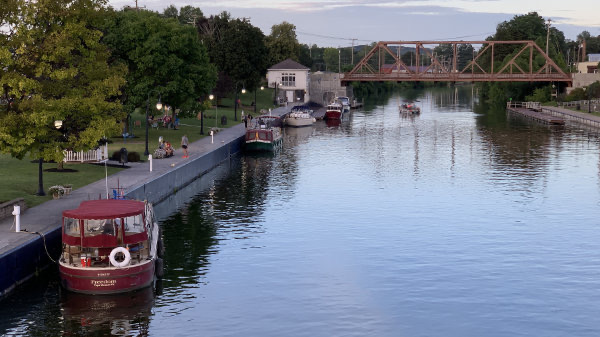
The dock at Newark when we walked across the bridge for dinner. And yes, that is Seneca parked halfway down the wall.
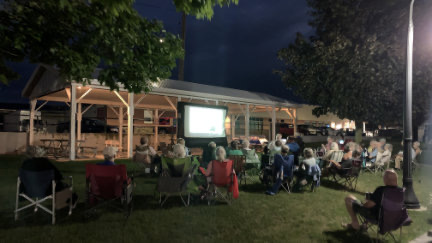
A history presentation was under way in the park when we returned from dinner.
After hooking up power and getting a little organized, we crossed the canal for dinner at the closest restaurant, a place with a limited but certainly sufficient menu. We had drinks and dinner and even dessert. Then we walked back to Nano. A slide show presentation was in progress in the park adjacent to the boat dock, but it was quiet enough.
Back on board, I organized myself for a shower and trip to the laundry facility first thing in the morning. Then I put on my pajamas and went to bed.
I was exhausted.
